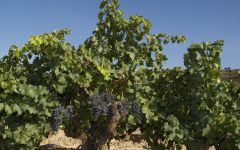Bodegas Montecillo Singladuras Albarino 2018



Product Details
Your Rating
Somm Note
Winemaker Notes
An attractive, pale lemon color with touches of green. Very elegant nose, with wine flavors such as jasmine and orange blossom followed by notes of sweet apple and dried herbs with a saline background. In the mouth it is rich and full of flavor, with a glycerine texture. It is marked by lively acidity that envelopes the notes of flowers and citrus mixed with aromatic herbs. Full-bodied, long and balanced.
Extremely versatile for pairing with Indian, Mexican and Thai cuisine – dishes such as Chicken Tikka Masala or Pad Thai, or a traditional pairing like seafood, clams or oysters.







Established in 1870, Bodegas Montecillo is one of the oldest wineries in the D.O. Rioja. The name, Montecillo—or little mountain—speaks to the irregular topography of the Rioja vineyards. Surrounded by vines and close to the waters of the majestic Ebro river, the city of Fuenmayor is set amongst flat topped hills, and in the distance, the distinctive rocky mass of the Cantabrian Mountains.
Montecillo’s ancient underground ‘bodega’ houses hand stacked bottles that remain undisturbed until reaching optimal roundness, including vintages that date back to 1926, the year that the Rioja Designation of Origin was created. The wines are crafted to enjoy a long bottle life; they continue bottle ageing longer than those from other wineries in the region.
Montecillo is also renowned for its female winemakers; led by oenologist Mercedes Garcia.

Bright and aromatic with distinctive floral and fruity characteristics, Albariño has enjoyed a surge in popularity and an increase in plantings over the last couple of decades. Thick skins allow it to withstand the humid conditions of its homeland, Rías Baixas, Spain, free of malady, and produce a weighty but fresh white. Somm Secret—Albariño claims dual citizenship in Spain and Portugal. Under the name Alvarinho, it thrives in Portugal’s northwestern Vinho Verde region, which predictably, borders part of Spain’s Rías Baixas.

Named after the rías, or estuarine inlets, that flow as far as 20 miles inland, Rías Baixas is an Atlantic coastal region with a cool and wet maritime climate. The entire region claims soil based on granite bedrock, but the inlets create five subregions of slightly different growing environments for its prized white grape, Albariño.
Val do Salnés on the west coast is said to be the birthplace of Albariño; it is the coolest and wettest of all of the regions. Having been named as the original subregion, today it has the most area under vine and largest number of wineries.
Ribeira do Ulla in the north and inland along the Ulla River is the newest to be included. It is actually the birthplace of the Padrón pepper!
Soutomaior is the smallest region and is tucked up in the hills at the end of the inlet called Ria de Vigo. Its soils are light and sandy over granite.
O Rosal and Condado do Tea are the farthest south in Rías Baixas and their vineyards actually cover the northern slopes of the Miño River, facing the Vinho Verde region in Portugal on its southern bank.
Albariño gives this region its fame and covers 90% of the area under vine. Caiño blanco, Treixadura and Loureira as well as occasionally Torrontés and Godello are permitted in small amounts in blends with Albariño. Red grapes are not very popular but Mencía, Espadeiro and Caiño Tinto are permitted and grown.
